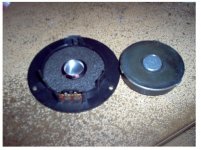Its no longer in the magnetic gap, so there may be minor change in parameters, nothing you could hear. If its an older speaker and sounds ok to you, i would not bother.
On the other hand if front plate is easily removable, four screws, you can at least take it apart and wipe it, clean it.
On the other hand if front plate is easily removable, four screws, you can at least take it apart and wipe it, clean it.
I don't see how the fluid could leak. I have messed around with that fluid before, still have some. It is attracted to magnets and it doesn't like to move around unless you move it. If you don't know the history of those tweeters, I wouldn't be surprised if what you see there is an attempt to add ferro fluid. It is messy stuff and difficult to clean up. When you buy the stuff it comes with a blotter type paper to clean up the old fluid or any mess you make. instead of leaking, what usually happens is it collects dust/debris and clumps up or dries out, then jams up the gap and the coil can't move. If the tweeter originally had the fluid then it will likely be worse without it.
Bit hard to know what is going on there. A tweeter model number would help.
Ferofluid is a brown oily liquid made of kerosine and iron oxide particles with a preservative.
It often dries up after about 20 years.
Usually easy enough to replace after taking the tweeter apart. Start by undoing the 4 screws on the faceplate. Lift the voicecoil out of the gap carefully and vertically.
Clean with a tissue or blotter.
And replace. This is enough for 5 tweeters:
http://www.bluearan.co.uk/index.php?id=SONFF05
You can run a tweeter without ferrofluid, but power handling is then compromised.
Ferofluid is a brown oily liquid made of kerosine and iron oxide particles with a preservative.
It often dries up after about 20 years.
Usually easy enough to replace after taking the tweeter apart. Start by undoing the 4 screws on the faceplate. Lift the voicecoil out of the gap carefully and vertically.
Clean with a tissue or blotter.
And replace. This is enough for 5 tweeters:
http://www.bluearan.co.uk/index.php?id=SONFF05
You can run a tweeter without ferrofluid, but power handling is then compromised.
Attachments
A word of caution. Morel tweeters need the tinsel leads unsoldering first.
Most others are straightforward.
Most others are straightforward.
I got my ferro fluid from PE and it did not come in a syringe. The packet it came in made it difficult to get into the gap without spilling everywhere. That’s what makes me think this mess is the result of a sloppy fluid replacement instead of fluid leaking out.
Leakage like that happens because the liquid/oil being used as the "fluid" for the ferrofluid is no longer sticking to the iron particles (holding the particles in solution).
So that liquid is no longer attracted to the magnetic gap, so it leaks out.
It was probably a inferior brand of ferrofluid used in that particular tweeter.
Sometimes you can see a similar thing happening with some cheaper fabric domed tweeters where the liquid is wicking into the fabric dome.
So that liquid is no longer attracted to the magnetic gap, so it leaks out.
It was probably a inferior brand of ferrofluid used in that particular tweeter.
Sometimes you can see a similar thing happening with some cheaper fabric domed tweeters where the liquid is wicking into the fabric dome.
The thinnest oil has migrated and left behind the iron filings in a thick oil slurry getting ready to lock up your tweeters. But at least they're doing it on both sides? Good opportunity to learn how to do an oil chan
- Home
- Loudspeakers
- Multi-Way
- Is this ferro fluid leakage
